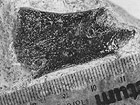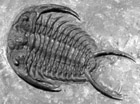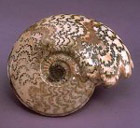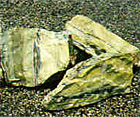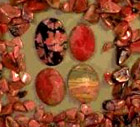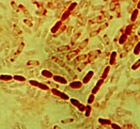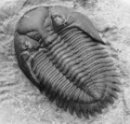

![]()
Volume 1, Issue 3
- Fossils of Newfoundland and Labrador
- Fossils of the Horton Bluff Assemblage, Nova Scotia
- Trilofest '97
- Death of a Fossil Site
- Ammonite Jewellery
- Archean Butterstone
- Rockhounding in Nova Scotia
- Rockhounding on Vancouver Island
- Microbial Communities Deep Below the Surface
- Diamond
- Cordierite - Part II
Welcome to the summer edition of the Canadian Rockhound. This issue features a variety of articles on rockhounding in Canada, with a focus on fossils and paleontology. Summer is the time Canadian's head out to beaches. The most popular attractions, of course, are Canada's east and west coasts. The coast is a great place to do rockhounding. In this issue we present stories on rockhounding in Nova Scotia and on Vancouver Island, British Columbia. On a more serious note, recent development near one coastal community in Great Britain has resulted in the destruction of an important fossil site. The destruction of that site is reported here.
Scientists have recently discovered that the earth beneath our feet is not entirely void of life as previously thought. Evidence shows that microbial communities are present deep within the earth. A better understanding of these communities may help scientists find better and more effective ways of cleaning up contaminated groundwater. The editor examines this fascinating topic.
This edition of the Canadian Rockhound sees more Canadian content. Many thanks to authors Doug Boyce, Rick Hudson, Chester Miller, Stuart Milliken, Ronnie Van Dommelen, Doug Wilson, Doug Miller, Garry Morse, Clive Knell, John Ratcliff, and the Mineral Society of Manitoba for their contributions. Have a great summer!
Dirk Schmid, Editor
E-mail
Fossils & Paleontology
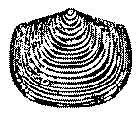 Brachiopod from Newfoundland. Drawing courtesy of Doug Boyce.
|
Fossils of Newfoundland
and Labrador
By Doug Boyce
The province of Newfoundland and Labrador is world famous for its fossils and has long been favored by collectors and researchers. Doug Boyce, Newfoundland's provincial paleontologist, describes the fossils found in Canada's easternmost province.
Fossils of the Horton Bluff Assemblage,
Nova Scotia
By Ronnie Van Dommelen
Beautifully situated at the mouth of the Avon River, the Horton Bluff formation, near Windsor, Nova Scotia produces a rich diversity of Early Carboniferous fossils. This was a period in Earth's history, 365 million years ago, when amphibians were still exploring dry land and reptiles and mammals had not yet developed.
Trilo-Fest '97
By Stuart Milliken
This special trilobite conference will be held in August 1997. It will be accessible to the collecting public at large. The "Trilofest" element of this conference is geared towards the beginner to advanced amateur collector. [Trilobite Photo Gallery].
Death of a Fossil Site
By Garry Morse
Lee-on-the-Solent in Hampshire, England, contains an important Middle Eocene exposure. The exposure is famous for the variety of fossils that were found within it. Unfortunately, the site was destroyed by Gosport Borough Council. Garry Morse reports on the sad destruction of this important site and the need to preserve fossil localities.
Ammonite Jewelry
By Chester Miller
Ammonite is a soft, but gem quality fossil. Chester Miller describes the process of making jewelry from Ammonite.
Archean Butterstone
By Clive Knell
Archean butterstone is ancient rock formed during the Archean Period, over 2.5 billion years ago. Found in southern Africa, this rock contains a variety of micro fossils, and may represent the beginnings of life on earth.
Rockhounding & Mineral Collecting
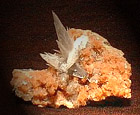 Calcite from Nova Scotia. Photo courtesy of Doug Wilson.
|
Rockhounding in Nova Scotia
By Doug Wilson
Nova Scotia boasts a varied geological history spanning almost 1 billion years. This Canadian east coast province spawned a productive gold mining industry in the 1860's. A variety of interesting minerals and fossils are found across the province. Doug Wilson provides a brief guide to rockhounding in Nova Scotia.
Rockhounding on Vancouver Island
By Rick Hudson
The creation of this 250 mile long island off the west coast of British Columbia, Canada, began 380 million years ago during the Devonian Era. Rick Hudson provides a brief guide to the unique geology of Vancouver Island and some of the many interesting gemstones, minerals and fossils found there.
Geomicrobiology
Microbial Communities Deep
Below the Surface
By Dirk Schmid
Within the last decade geologists and microbiologists have found substantial populations of bacteria deep below the earth's surface, at depths up to 2000 metres. How did they get there and what are they doing?
Diamond
By Doug Miller
Diamond is the hardest known material. It has been found in kimberlite pipes near Forte a la Corne, northeast of Prince Albert, Saskatchewan. Doug Miller describes the occurrance of Diamond in Saskatchewan.
Cordierite - Part II
By Richard Gunter
Richard Gunter concludes the series on Manitoba cordierite with a section on alteration zones.
Maps for Mineral and Fossil Collectors
You can purchase digitized maps of mineral and fossil occurrances in western Canada through John Ratcliff. Maps can be sent by e-mail as an attachment, or by snail mailed (regular post). Regular scanned maps cost $10.00 and you must supply the exact location you are interested in. Full size hard copy maps varing in scale from 1:15000 to 1:100000 (depending on how much detail you want) cost $15.00. The advantage to having maps sent as an attachement is that you will receive them a lot sooner. You may contact John at ratcliff@mail.ocis.net.
Rockhound Clubs in Canada - Where to find them
If you plan to do some rockhounding this summer, attend a gem and mineral show, or join a rockhound club in Canada, visit the Canadian Directory of Rock & Mineral Associations website (formerly "Rock & Mineral Associations of Canada"). This site is well organized and lists virtually every rockhound club functioning in Canada. It includes a show calendar and more than 30 offical club home pages. Browsing by province helps you find a club in your local area quickly. Club home pages list meeting times and locations, activities and contact information.
Alberta Paleontological Society
Official home page. This page contains information about the society, membership, and upcoming activities.
The Royal Tyrrell Museum
Official home page of the Royal Tyrrell Museum of Palaeontology in Drumheller, Alberta, Canada.
The Provincial Museum of Alberta
Official home page.
The Geological Time Scale
An image of the geological time scale.
The Hooper Paleontological Museum
Museum situated in Carleton, Ontario.

Copyright © 1997 Canadian Rockhound
Website created by Dirk Schmid
Images of minerals are Copyright ©1997
theImage.com
unless otherwise noted.
Trilobite images on this website
Copyright ©1997 Steve Anderson
Magazine Issues |
News & Events |
Junior Rockhound
Resources |
Clubs |
Dealers |
Links |
Home
